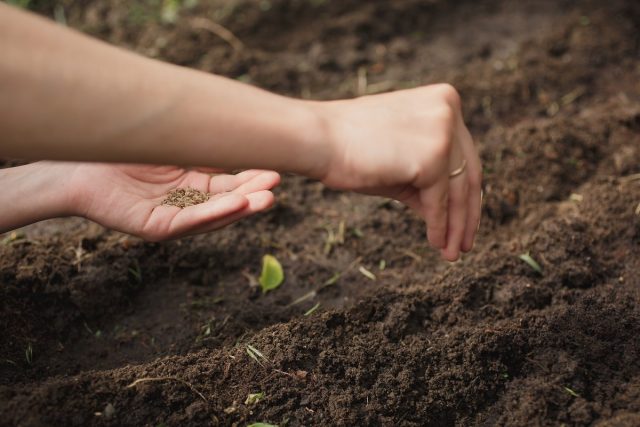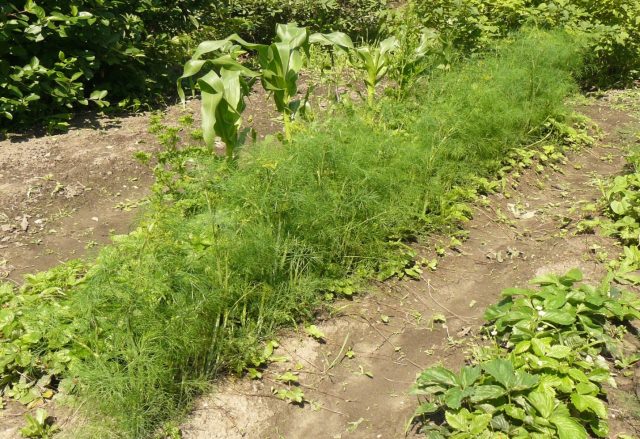Content
Dill Kibray is very popular in Russia, which is primarily due to the good frost resistance of the variety - it is successfully grown in all regions of the country, including in the north. In addition, this crop is distinguished by high yield and leafiness.
The originators of the variety are the breeders of the All-Russian Research Institute of Plant Production named after V.I. N.I. Vavilov. In 1991, dill Kibray was officially included in the state register of the Russian Federation and recommended for planting throughout the country.
Description of the variety of dill Kibray
The variety was developed in the course of breeding work as a variety intended for obtaining greenery. Kibray dill is not grown for umbrellas, but if desired, the variety is still used for winter harvesting - this part of the plant ripens in sufficient quantities, although quite late.
As you can see in the photo below, the leaf plate of the Kibray variety of dill is wide, but with a pronounced dissection. The height of the plant varies from 30 to 40 cm; a thin layer of wax is clearly felt on the leaves. A distinctive external feature is a kind of yellowness, which, unknowingly, is taken as a sign of drying out.
Yield
The yield of the Kibray variety is 3 kg of greens from 1 m2... If you grow it with spices, then the yield will be about 1.5-2 kg from 1 m2... An adult plant weighs an average of 25-30 g.
Dill reaches maturity 40-45 days after planting. The timing of harvesting largely depends on how you plan to use the plant. For fresh consumption, the greens can be plucked throughout the entire growth of the dill. However, it is recommended to collect it in the morning. Tear off individual leaves or cut the shoots to their full length.
For freezing or drying, Kibray dill is harvested when it reaches a height of 30 cm. For further use as a spice, the plant is removed from the beds 2 months after planting. The seeds are harvested after the umbrellas turn gray and harden.
Sustainability
According to the description, Kibray dill tolerates low temperatures well. It is one of the most frost-resistant garden crops - the seeds of the variety can germinate at a temperature of 3 ° C. For the normal development of plantings, 8-10 ° C is enough, but in the same way dill is able to safely tolerate frosts down to -5 ° C.
Heat resistance and drought resistance is low. The Kibray variety loves moisture and quickly loses its juiciness in conditions of prolonged drought.
Of the planting diseases of dill, powdery mildew is most often affected, especially in conditions of high humidity, however, resistance to this disease was introduced into the Kibray variety by selection. Therefore, the plant can be planted even in lowlands, where there is an accumulation of precipitation and water from irrigation.
Advantages and disadvantages
The advantages of Kibray dill include the following qualities:
- good yield of green mass;
- versatility of application;
- cold resistance;
- immunity to typical diseases of dill;
- long periods of storage of the crop.
The variety has no major drawbacks, except for its low drought resistance. But this characteristic unites almost all types of dill.Also, some gardeners attribute late ripening periods to the disadvantages of the variety.
Landing rules
When choosing a place for planting Kibray dill, one should focus on open, well-lit areas. In shaded conditions, the plant slowly gains green mass. In addition, crop rotation must be taken into account. It is best to plant the Kibray variety where such crops previously grew:
- cabbage;
- tomatoes;
- legumes;
- cucumbers.
In the fall, it is recommended to dig up the site selected for planting and apply fertilizer to the soil. In the role of the first feeding, a mixture of ammonium nitrate (15 g), superphosphate (10 g) and potassium salt (10 g) is used.
Sowing of seeds is carried out mainly in April-May. You can also plant dill in the fall, before winter. The recommended planting depth of planting material is no more than 2 cm. The distance between two neighboring plants should not be less than 20 cm. Dill should not be planted too rarely - such an arrangement will provoke active growth of weeds between shoots.
Growing dill Kibray
Caring for the Kibray variety is not complicated and comes down to basic procedures:
- loosening;
- weeding;
- watering;
- fertilization of the soil.
If you prepare a site in advance for planting in the fall, then additional fertilizing of the plantings may not be needed. The fact that plants lack nutrients can be determined by their appearance - the lack of nitrogen is evidenced by early flowering and a bright yellow color (not to be confused with a varietal trait, which is expressed in a yellowish tint of the leaves).
You can fill the lack of trace elements by fertilizing the soil with urea in a proportion of 1 tsp. 10 liters of water. Also, the plant responds well to feeding with fermented nettle infusion. In this case, fertilizing the soil will help scare off pests (for example, aphids).
Weed the beds as needed. There is no need to keep the dill planting in perfect condition, however, the abundance of weeds retains moisture in the soil and can lead to waterlogging of the site. Loosening of the soil is carried out for a better supply of oxygen to the roots of the plant. At the same time, it is not recommended to exceed the depth of 7-8 cm, so as not to damage the soil structure.
Planting is watered with an orientation to the topsoil - it should not crack and dry out, but greens should not be poured either. The optimal frequency of watering is 2 times a day. In this regard, the maintenance of the beds is facilitated by the installation of an automatic irrigation system.
Diseases and pests
Kibray practically does not get sick, but if this did happen, then powdery mildew affects the beds. At the first signs of the disease, plantings are sprayed with a weak solution of a suspension of sulfur: 20 g of substance per 10 liters of water.
Preventive measures include observing the following rules:
- dill is planted taking into account crop rotation;
- after harvesting, the site is dug to a great depth;
- the beds are watered sparingly, without flooding.
Among insects, the Kibray variety most often affects aphids. You can fight it with the help of an alcoholic liquid, which is diluted in the form of a solution: 2 tbsp. l. "Troy" for 10 liters of water. In addition, the smell of thyme repels aphids, so the beds can be surrounded by these plants. Finally, liquid organic fertilizers cope well with the pest. Nitrate is best suited for this.
Additionally about the features of Kibray dill:
Conclusion
Dill Kibray develops well even with minimal maintenance. The main conditions under which you can get a rich harvest are sun and regular watering. Top dressing is applied at will, weeding the beds as needed.
The collected greens are placed in the refrigerator - this way they retain their qualities from 5 to 7 days. For longer storage, the plant is frozen or dried. Dry greens are stored in a dark place.












